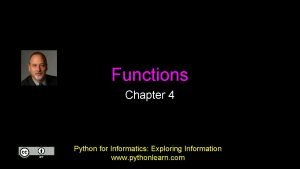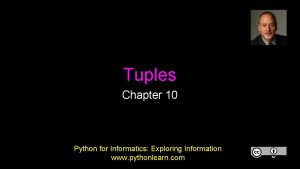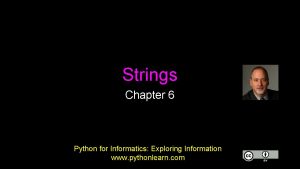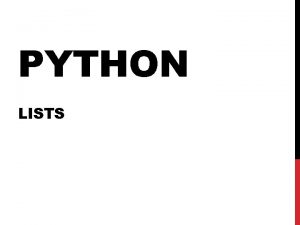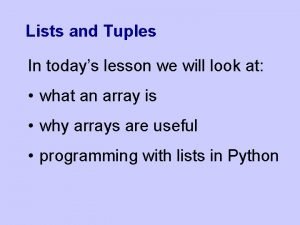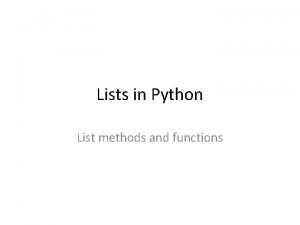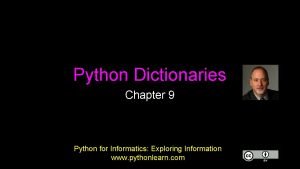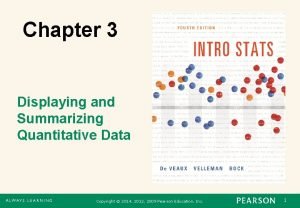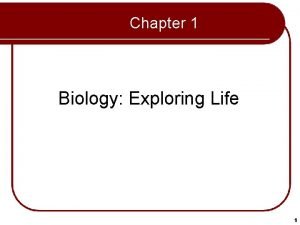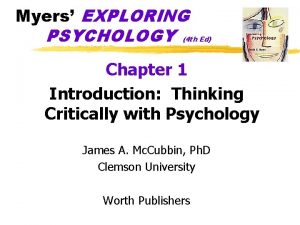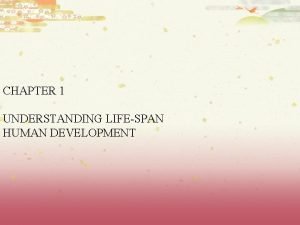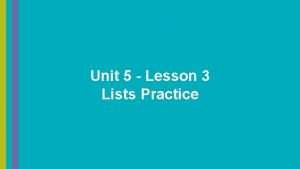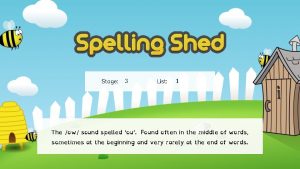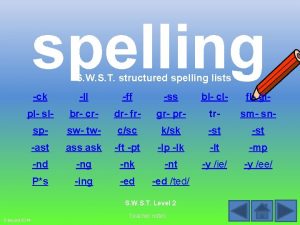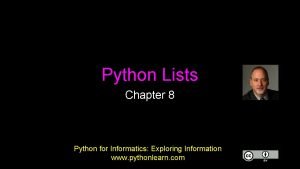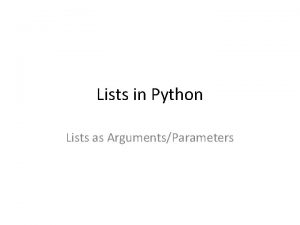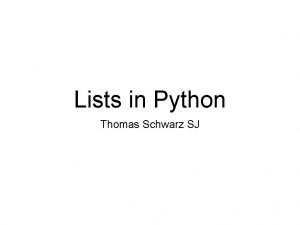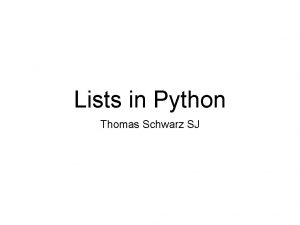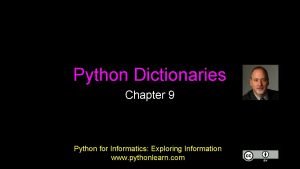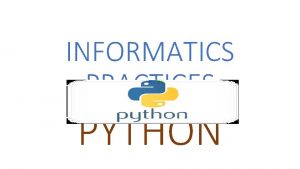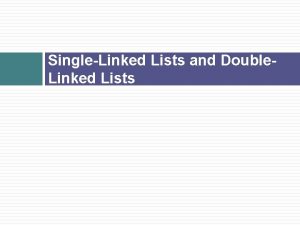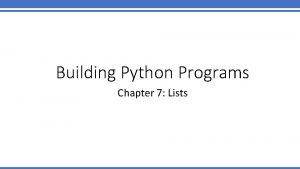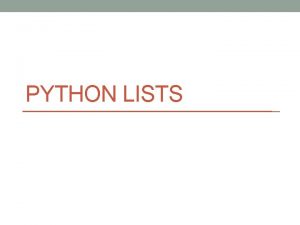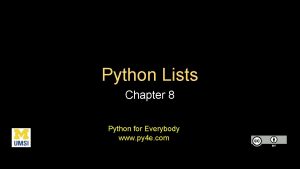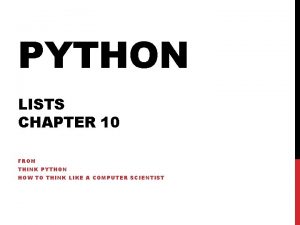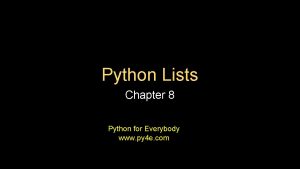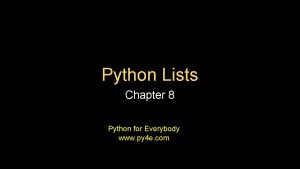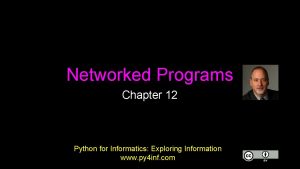Python Lists Chapter 8 Python for Informatics Exploring





![We already use lists! for i in [5, 4, 3, 2, 1] : print We already use lists! for i in [5, 4, 3, 2, 1] : print](https://slidetodoc.com/presentation_image_h2/bcb1ec0864b7761a07549c56aaafa2b3/image-6.jpg)
![Lists and definite loops - best pals friends = ['Joseph', 'Glenn', 'Sally'] for friend Lists and definite loops - best pals friends = ['Joseph', 'Glenn', 'Sally'] for friend](https://slidetodoc.com/presentation_image_h2/bcb1ec0864b7761a07549c56aaafa2b3/image-7.jpg)




![A tale of two loops. . . friends = ['Joseph', 'Glenn', 'Sally'] >>> friends A tale of two loops. . . friends = ['Joseph', 'Glenn', 'Sally'] >>> friends](https://slidetodoc.com/presentation_image_h2/bcb1ec0864b7761a07549c56aaafa2b3/image-12.jpg)
















- Slides: 28

Python Lists Chapter 8 Python for Informatics: Exploring Information www. pythonlearn. com

Unless otherwise noted, the content of this course material is licensed under a Creative Commons Attribution 3. 0 License. http: //creativecommons. org/licenses/by/3. 0/. Copyright 2010 - Charles Severance

A List is a kind of Collection • • A collection allows us to put many values in a single “variable” A collection is nice because we can carry all many values around in one convenient package. friends = [ 'Joseph', 'Glenn', 'Sally' ] carryon = [ 'socks', 'shirt', 'perfume' ]

What is not a “Collection” • Most of our variables have one value in them - when we put a new value in the variable - the old value is over written $ python Python 2. 5. 2 (r 252: 60911, Feb 22 2008, 07: 53) [GCC 4. 0. 1 (Apple Computer, Inc. build 5363)] on darwin >>> x = 2 >>> x = 4 >>> print x 4

List Constants • • • List constants are surrounded by square brakets and the elements in the list are separated by commas. A list element can be any Python object - even another list A list can be empty >>> print [1, 24, 76]>>
![We already use lists for i in 5 4 3 2 1 print We already use lists! for i in [5, 4, 3, 2, 1] : print](https://slidetodoc.com/presentation_image_h2/bcb1ec0864b7761a07549c56aaafa2b3/image-6.jpg)
We already use lists! for i in [5, 4, 3, 2, 1] : print 'Blastoff!' 5 4 print i 3 2 1 Blastoff!
![Lists and definite loops best pals friends Joseph Glenn Sally for friend Lists and definite loops - best pals friends = ['Joseph', 'Glenn', 'Sally'] for friend](https://slidetodoc.com/presentation_image_h2/bcb1ec0864b7761a07549c56aaafa2b3/image-7.jpg)
Lists and definite loops - best pals friends = ['Joseph', 'Glenn', 'Sally'] for friend in friends : print 'Happy New Year: ', friend print 'Done!' Happy New Year: Joseph. Ha

Looking Inside Lists • Just like strings, we can get at any single element in a list using an index specified in square brackets Joseph Glenn 0 1 Sally 2 >>> friends = [ 'Joseph', 'Glenn', 'Sally'

Lists are Mutable • • Strings are "immutable" we cannot change the contents of a string - we must make a new string to make any change Lists are "mutable" - we can change an element of a list using the index operator >>> fruit = 'Banana'>>> fruit[0] = 'b'Traceback Type. Error: 'str' object does not support item assignment>>> x = fruit. lower()>>> print xbannna>>> lotto = [2, 14, 26, 41, 63]>>> print lotto[2, 14, 26, 41, 63]>>> lotto[2] = 28>>> print lotto[2, 14, 28, 41, 63]

How Long is a List? • • The len() function takes a list as a parameter and returns the number of elements in the list Actually len() tells us the number of elements of any set or sequence (i. e. such as a string. . . ) >>> greet = 'Hello Bob'>>> print >>> x = [ 1, 2, 'joe', 99]>>> print

Using the range function • • The range function returns a list of numbers that range from zero to one less than the parameter We can construct an index loop using for and an integer iterator >>> print range(4) [0, 1, 2, 3] >>> friends = ['Joseph', 'Glenn', 'Sally
![A tale of two loops friends Joseph Glenn Sally friends A tale of two loops. . . friends = ['Joseph', 'Glenn', 'Sally'] >>> friends](https://slidetodoc.com/presentation_image_h2/bcb1ec0864b7761a07549c56aaafa2b3/image-12.jpg)
A tale of two loops. . . friends = ['Joseph', 'Glenn', 'Sally'] >>> friends = ['Joseph', 'Glenn', 'Sally for friend in friends : print 'Happy New Year: ', friend for i in range(len(friends)) : friend = friends[i] print 'Happy New Year: ', friend Happy New Year: Joseph. Happy N

Concatenating lists using + • We can create a new list by adding two exsiting lists together >>> a = [1, 2, 3]>>> b = [4, 5, >>> print a [1, 2, 3]

Lists can be sliced using : Remember: Just like in strings, the second >>> t = [9, 41, 12, 3, 74, 15]>>> t[1: 3][41, 12]>>> t[: 4][9, 41, 12, 3]>>> t[3 number is "up to but not >>> t[: ][9, 41, 12, 3, 74, 15] including"

List Methods >>> x = list()>>> type(x)<type 'list'>>>> dir(x)['append', 'count', 'extend', 'index', 'insert', 'pop', 'remove', 'reverse', 'sort']>>> http: //docs. python. org/tutorial/datastructures. html

Building a list from scratch • • We can create an empty list and then add elements using the append method The list stays in order and new elements are added at the end of the list >>> stuff = list()>>> stuff. append('b

Is Something in a List? • • • Python provides two operators that let you check if an item is in a list These are logical operators that return True or False They do not modify the list >>> some = [1, 9, 21, 10, 16]>>>

• • • A List is an Ordered Sequence A list can hold many items and keeps those items in the order until we do something to change the order A list can be sorted (i. e. change its order) The sort method (unlike in strings) means "sort yourself" >>> friends = [ 'Joseph', 'Glenn', 'Sally

Built in Functions and Lists • • There a number of functions built into Python that take lists as parameters Remember the loops we built? These are much simpler http: //docs. python. org/lib/built-in-funcs. html >>> nums = [3, 41, 12, 9, 74, 15]>> >>> print sum(nums)/len(nums)25

Enter a number: 3 Enter a num total = 0 count = 0 while True : Averaging with a list inp = raw_input('Enter a number: ') if inp == ' numlist = list()while True : inp = raw

Best Friends: Strings and Lists >>> abc = 'With three words'>>> stuff = abc. split()>>> print stuff['With', 'th >>> print len(stuff) 3 >>> print stuff['With', 'three', 'wo >>> print stuff[0] With Split breaks a string into parts produces a list of strings. We think of these as words. We can access a particular word or loop through all the words.

>>> line = 'A lot of spaces'>>> etc = line. split()>>> 'of', a Whenprint youetc['A', do not'lot', specify 'spaces']>>> delimiter, multiple spaces are >>> line = 'first; second; third'>>> thing = line. split()>>> print treated like “one” delimiter. thing['first; second; third']>>> print len(thing)1>>> thing = line. split('; ')>>> print thing['first', 'second', 'third']>>> print len(thing)3 You can specify what delimiter >>> character to use in the splitting.

From stephen. marquard@uct. ac. za Sat Jan 5 09: 14: 16 2008 fhand = open('mbox-short. txt')for line in fhand: line =Sat. Fri line. rstrip() >>> line = 'From stephen. marquard@uct. ac. za Sat Jan 5 09: 14: 16 2008'

The Double Split Pattern • Sometimes we split a line one way and then grab one of the pieces of the line and split that piece again From stephen. marquard@uct. ac. za. Sat Jan 5 09: 14: 16 2008 words = line. split() email = words[1] pieces = email. split('@') print pieces[1] ['stephen. marquard', 'uct. ac. za'] 'uct. ac. za'

The Double Split Pattern • Sometimes we split a line one way and then grab one of the pieces of the line and split that piece again From stephen. marquard@uct. ac. za Sat Jan 5 09: 14: 16 2008 words = line. split() email = words[1] pieces = email. split('@') print pieces[1] stephen. marquard uct. ac. za stephen. marquard@uct. ac. za ['stephen. marquard', 'uct. ac. za'] 'uct. ac. za'

The Double Split Pattern • Sometimes we split a line one way and then grab one of the pieces of the line and split that piece again From stephen. marquard@uct. ac. za Sat Jan 5 09: 14: 16 2008 words = line. split() email = words[1] pieces = email. split('@') print pieces[1] stephen. marquard@uct. ac. za ['stephen. marquard', 'uct. ac. za'] 'uct. ac. za'

The Double Split Pattern • Sometimes we split a line one way and then grab one of the pieces of the line and split that piece again From stephen. marquard@uct. ac. za Sat Jan 5 09: 14: 16 2008 words = line. split() email = words[1] pieces = email. split('@') print pieces[1] stephen. marquard@uct. ac. za ['stephen. marquard', 'uct. ac. za'] 'uct. ac. za'

List Summary • Concept of a collection • Lists and definite loops • Indexing and lookup • List mutability • Functions: len, min, max, sum • Slicing lists
 Python for informatics
Python for informatics Python for informatics: exploring information
Python for informatics: exploring information Python for informatics
Python for informatics Banaprint
Banaprint Python plot list of lists
Python plot list of lists Lists of tuples python
Lists of tuples python List methods python
List methods python Python for informatics
Python for informatics Chapter 26 documentation and informatics
Chapter 26 documentation and informatics Career skills in health informatics chapter 2
Career skills in health informatics chapter 2 Chapter 26 exploring the universe answers
Chapter 26 exploring the universe answers Exploring religions chapter 4 large
Exploring religions chapter 4 large Development takes place gradually
Development takes place gradually Exploring globalization textbook pdf chapter 11
Exploring globalization textbook pdf chapter 11 Religion
Religion Exploring the religions of our world chapter 1 pdf
Exploring the religions of our world chapter 1 pdf Exploring religions chapter 6 large
Exploring religions chapter 6 large Exploring religions chapter 5 large
Exploring religions chapter 5 large Chapter 3 displaying and summarizing quantitative data
Chapter 3 displaying and summarizing quantitative data Chapter 2 exploring the americas study guide
Chapter 2 exploring the americas study guide Chapter 2 exploring the americas answer key
Chapter 2 exploring the americas answer key Chapter 1 biology exploring life
Chapter 1 biology exploring life Exploring psychology chapter 1
Exploring psychology chapter 1 Exploring lifespan development chapter 1
Exploring lifespan development chapter 1 Sociocultural graded influences
Sociocultural graded influences What is semicolon
What is semicolon Lesson 3 lists practice
Lesson 3 lists practice Spelling shed
Spelling shed Swst lists
Swst lists
